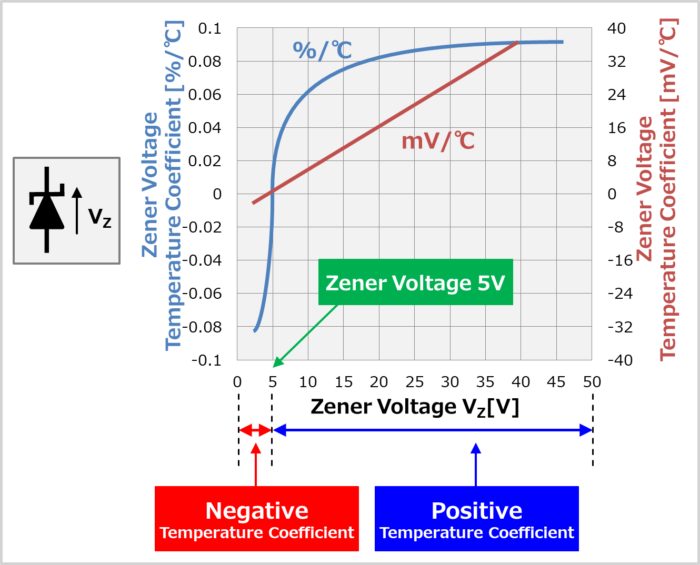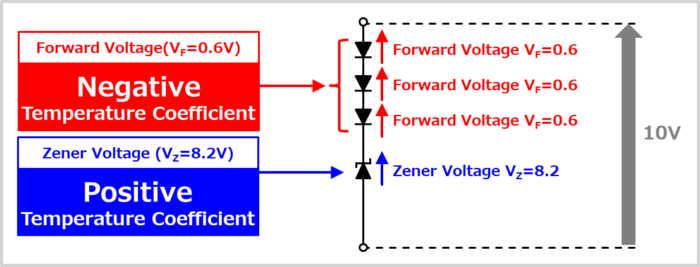Regarding the temperature coefficient of zener diode: This article will explain the information below.
- Characteristics of Temperature Coefficient of Zener Diode
- Method of Temperature Compensation of Zener Diode
Characteristics of Temperature Coefficient of Zener Diode

The zener voltage of a zener diode varies with temperature.
Depending on the magnitude of the zener voltage, a zener diode may have a positive or negative temperature coefficient.
Those with a Zener voltage higher than around 5V have a positive temperature coefficient, so the zener voltage increases as the temperature rises.
On the other hand, those whose zener voltage is lower than around 5V have a negative temperature coefficient, so the zener voltage decreases as the temperature rises.
In addition, the positive and negative temperature coefficients cancel each other for zener diodes with a zener voltage near 5V, resulting in a small temperature change.
The reason why the positive and negative temperature coefficients switch at the boundary around the zener voltage of 5V is that the zener diode is an element that functions with the tunneling and avalanche effects.
The avalanche effect has a positive temperature coefficient. On the other hand, the tunneling effect has a negative temperature coefficient.
Therefore, zener voltage higher than around 5V has a positive temperature coefficient because the avalanche effect is dominant.
On the other hand, for zener voltages lower than around 5V, the temperature coefficient is negative because the tunneling effect is dominant.
Supplement
- Since the temperature coefficient is small when the zener voltage is around 5V, zener diodes used as reference voltages are often around 5V.
Method of Temperature Compensation of Zener Diode

Zener diodes with a zener voltage exceeding 5V have a positive temperature coefficient. Therefore, elements with a negative temperature coefficient must be connected in series for temperature compensation.
The forward voltage of a typical diode or the voltage between the base and emitter of a transistor is about 0.6 to 0.7V, which has a negative temperature coefficient (about -2.5mV/°C).
Therefore, a Zener diode with a positive temperature coefficient can be connected in series with a diode with a negative temperature coefficient to cancel the temperature coefficient.
If a single diode cannot cancel the temperature coefficient, increase the number of diodes connected in series. In this case, it is necessary to take into account that the forward voltage of the series-connected diodes raises the voltage by about 0.6 to 0.7V. For example, if three diodes are connected to an 8.2V Zener diode, the voltage at both ends will be approximately 10V, 8.2V + 0.6V x 3 = 10V.
Another commonly used method is to connect in series a zener diode with a zener voltage around 5 V, which has a small temperature coefficient, to improve the temperature characteristics.
Summary
In this article, the following information on the temperature coefficient of zener diode was explained.
- Characteristics of Temperature Coefficient of Zener Diode
- Method of Temperature Compensation of Zener Diode
Thank you for reading.
Related article
"Information about Zener diodes" is explained in detail in the following articles. If you are interested, please check it out from the link below.